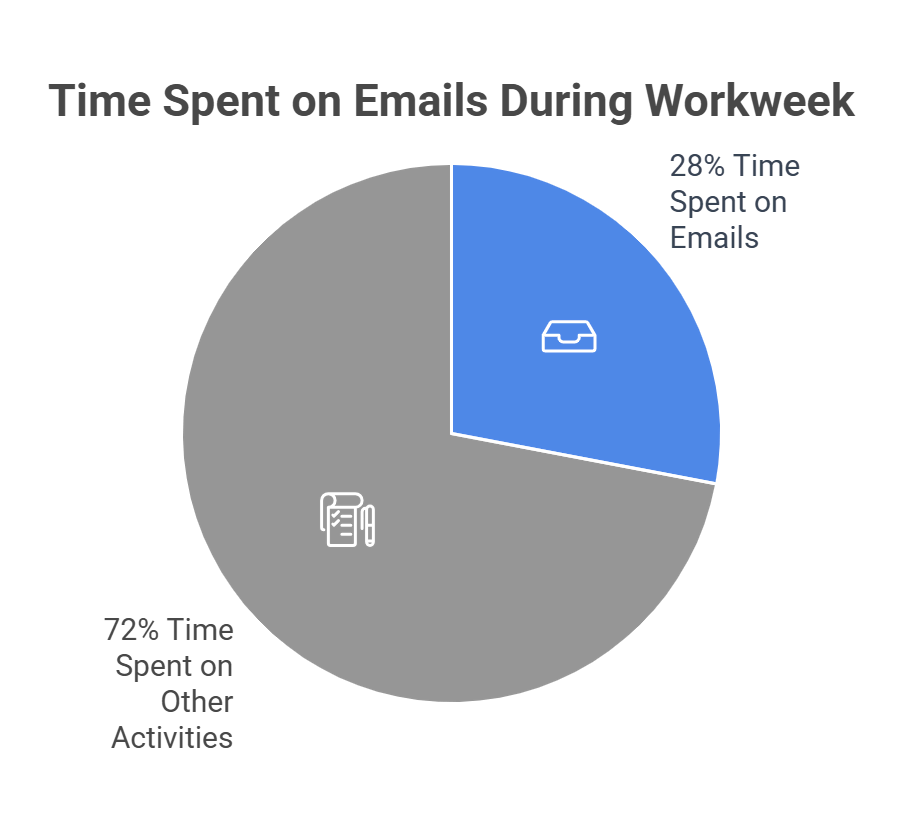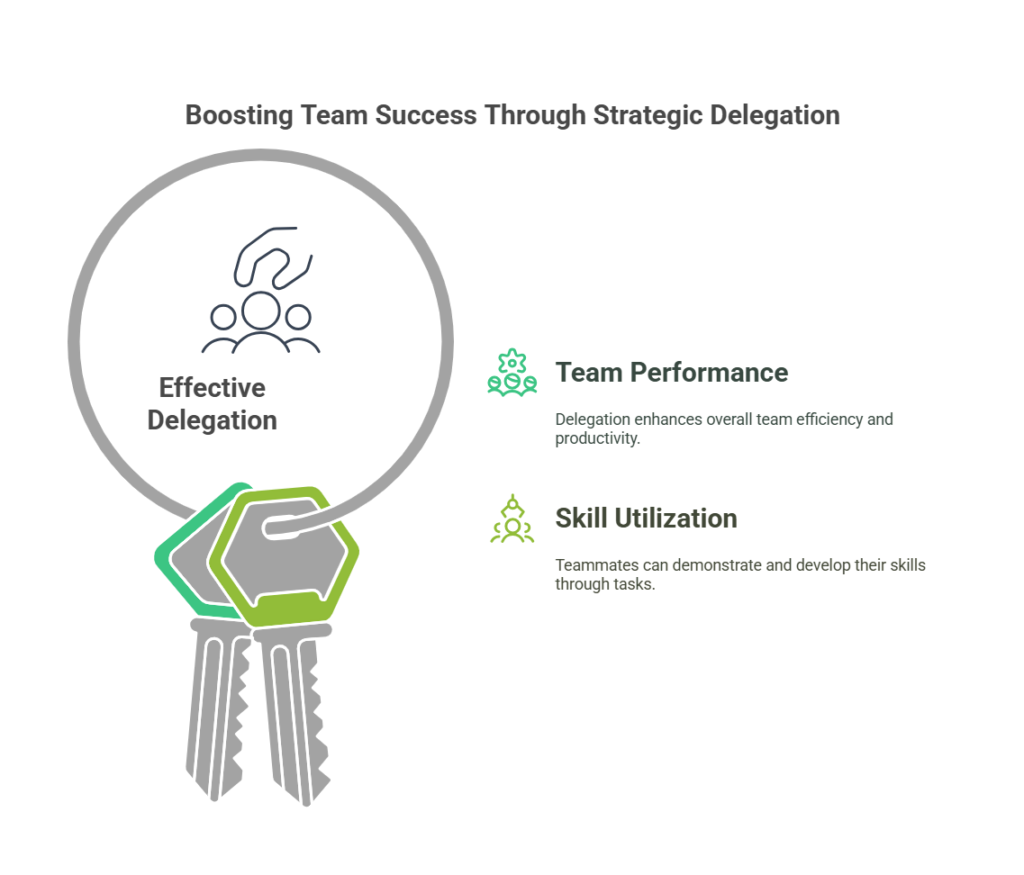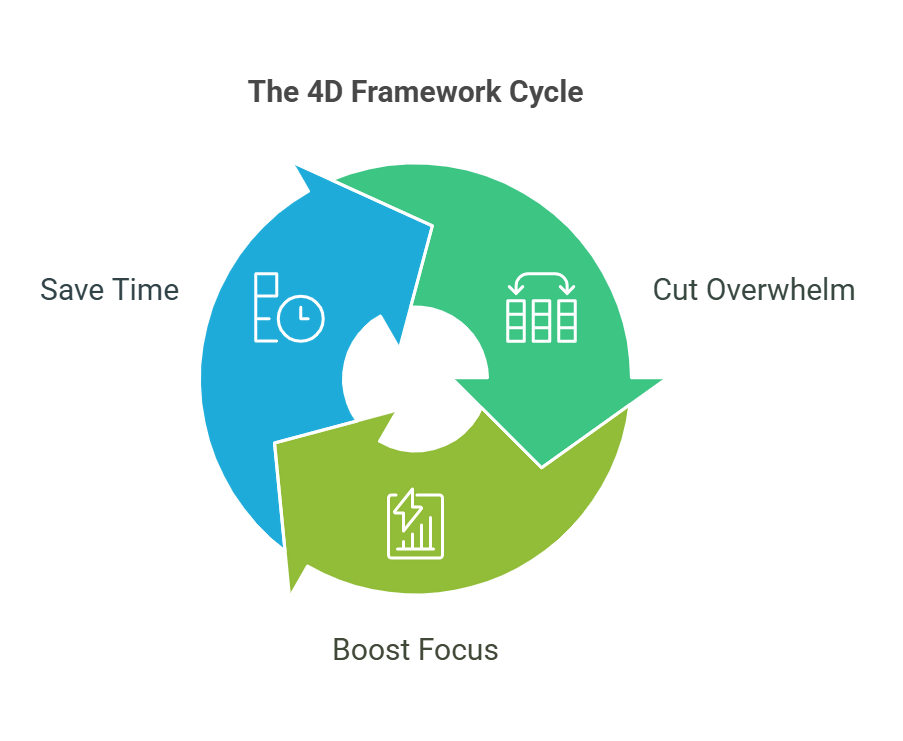Ever had one of those days where your to-do list feels like it’s out to get you? Between emails, deadlines, and those random errands that pop out of nowhere, it’s enough to make anyone want to throw in the towel. Enter the 4D Framework—your secret weapon to tackle tasks without breaking a sweat. It’s simple, it’s practical, and best of all, it works. Let me break it down for you.
What’s the 4D Framework All About?
Think of the 4D Framework as the Marie Kondo method for your workload. It’s all about cutting the clutter and focusing on what actually matters. Here’s how it works:
- Delete: Let go of the stuff that’s just wasting your time.
- Delegate: Pass it off to someone who can handle it.
- Defer: Push it to a later time (but don’t forget about it).
- Do: If it’s important and urgent, get it done now.
The goal? To spend less time stressing and more time on what counts.

Let’s Dive Into the 4Ds
1. Delete: Just Say No
Not every task deserves your time or attention. Some things are just…fluff. Learn to say “no” or simply let go of the stuff that doesn’t move the needle.
Example:
You’re drowning in a sea of emails, half of which are spam or irrelevant newsletters. Hit that unsubscribe button and reclaim your inbox.

Why It’s Worth It:
A McKinsey study found that we spend a whopping 28% of our workweek on emails. Imagine how much time you’d save by deleting the junk.
2. Delegate: Share the Workload
Delegation isn’t about pawning off work—it’s about being smart with your time. Think of it like sharing the load so you can focus on the bigger picture.
Example:
Planning a party? Delegate the food prep to one friend and the playlist to another. Suddenly, it’s way less overwhelming.

Why It’s Worth It:
Research in the Journal of Management shows that effective delegation boosts team performance by 25%. Plus, your teammates get to show off their skills—it’s a win-win.
3. Defer: Hit Pause Without Procrastinating
Not everything needs to be done right this second. Deferring tasks lets you focus on what’s urgent while still keeping non-urgent tasks on your radar.
Example:
You’ve got a presentation due in two weeks. Instead of stressing about it today, block out time in your calendar next week to work on it. Boom, it’s off your plate for now.
Pro Tip:
Pair this with the Eisenhower Matrix, which helps you figure out what’s urgent vs. what can wait. It’s like a compass for your priorities.
4. Do: Handle the Important Stuff
This is where the magic happens. If something is both urgent and important, roll up your sleeves and knock it out.
Example:
Your boss needs that quarterly report by the end of the day. That’s a “Do” task. Everything else? It can wait.
Why It Works:
Using tools like the Pomodoro Technique (work for 25 minutes, then take a short break) keeps you laser-focused and prevents burnout.
Why the 4D Framework Works So Well
This strategy isn’t just about clearing tasks—it’s about working smarter. Here’s why it’s a total game-changer:

- Cuts Overwhelm: Sorting tasks into categories makes even the busiest day feel manageable.
- Boosts Focus: You’re only spending energy on what matters.
- Saves Time: No more spinning your wheels on low-priority stuff.
Stat Check:
A 2021 Asana report revealed that workers waste about 60% of their time on “work about work” (like emails and meetings). The 4D Framework helps cut that nonsense.
Real-World Applications of the 4D Framework: Why It’s a Game-Changer
Let me tell you something: the 4D Framework isn’t just another buzzword—it’s a legit lifesaver for people buried in emails, endless to-do lists, and the chaos of everyday life. Whether you’re running a business, pulling all-nighters as a student, or just trying to keep your head above water at home, this framework works.
Let’s dive into how it’s being used in the real world—and I mean everywhere—and why people are raving about it.

1. In Corporate Life: Cutting the Clutter
You know how work feels like juggling flaming swords sometimes? Meetings, emails, deadlines—it’s chaos. The 4D Framework swoops in like a productivity superhero, helping people figure out what to delete, delegate, defer, or just get done.
Example: Google’s Genius Approach to Delegation
At Google, managers don’t waste time scheduling meetings or putting together reports. They delegate all that jazz to focus on the big stuff—like world domination, probably. It’s delegation with purpose, and it keeps their creative juices flowing.
Why It’s Awesome:
- A Harvard Business Review study says managers who delegate well save 20% of their time. That’s like getting Friday afternoon off every week.
- Oh, and did you know the average office worker spends 28% of their week just wrangling emails? The 4D Framework can chop that down big time.
Takeaway: If you’re tired of drowning in busywork, this framework can help you break free and get back to the stuff that actually matters—like nailing that big presentation or, I don’t know, taking a lunch break for once.
2. In Healthcare: Saving Time (and Lives)
Let’s talk about healthcare, where there’s no time for indecision. Doctors and nurses are pros at using a 4D-like approach—though they probably don’t call it that—to make quick, smart decisions. It’s all about figuring out what’s urgent and what can wait.
Example: ER Triage on Steroids
Emergency rooms are basically organized chaos, right? They use a natural form of the 4D Framework:
- Delete: Forget unnecessary tests when seconds matter.
- Delegate: Nurses handle patient monitoring while the doc tackles the big emergencies.
- Defer: Schedule non-urgent cases for later.
- Do: Focus 100% on life-threatening stuff—like, now.
Cool Stat:
Hospitals that prioritize tasks like this cut patient wait times by 30% and improve outcomes by 25%. That’s some serious ROI for a little prioritization!
Takeaway: Whether you’re saving lives or just trying to survive your inbox, breaking tasks into “Do it now” vs. “Do it later” can save you major stress.
3. For Coders: Wrangling Complex Projects
Software developers are basically modern-day wizards, but even they get overwhelmed. Between bugs, sprints, and last-minute feature requests, it’s a lot. The 4D Framework fits right into Agile project management like a glove.
Example: Agile in Action
Agile teams live and breathe the 4D Framework:
- Delete: Drop features that aren’t essential for the next sprint.
- Delegate: Have team members specialize—someone codes, someone tests, someone designs.
- Defer: Push the “nice-to-haves” to future updates.
- Do: Tackle high-priority features first.
Fun Fact:
Developers using structured frameworks like Agile are 35% more productive, according to Stack Overflow. Plus, projects get done 37% faster. Boom.
Takeaway: Whether you’re building the next killer app or just trying to troubleshoot your Wi-Fi, this framework keeps you on track without the stress spiral.
4. For Students: Fighting the Overwhelm
Ah, student life—the never-ending mountain of assignments, group projects, and exams. If you’ve ever pulled an all-nighter wondering where all your time went, the 4D Framework is here to save you.
Example: The Exam Cram Plan
Picture this: You’ve got exams next week, and your to-do list is a mile long. Here’s how you could use the 4D Framework:
- Delete: Skip the fluff. Focus on the material that’s most likely to be on the test.
- Delegate: Divide group project tasks with classmates instead of doing it all yourself (you know you were going to).
- Defer: Put less urgent topics on tomorrow’s list.
- Do: Crush that essay due tomorrow first.
Proven by Science:
Students who use prioritization frameworks like this score 22% higher on exams, says a study in the Journal of Educational Psychology. That’s an A instead of a B, folks.
Takeaway: The 4D Framework is like a cheat code for school. It helps you focus on what actually matters and skip the stuff that doesn’t.
5. For Everyday Life: Keeping the Chaos in Check
Okay, let’s get real—life outside work and school can be just as hectic. From household chores to grocery shopping, there’s always something that needs to be done. The 4D Framework? It’s basically your life manager.
Example: Weekend Chores, Simplified
Here’s how you could handle a massive Saturday to-do list:
- Delete: Does the pantry really need to be reorganized today? Nope.
- Delegate: Get the kids to help with laundry or ask your partner to handle groceries.
- Defer: Push yard work to next weekend.
- Do: Pay the bills before they’re overdue.
Survey Says:
People who use prioritization tools save up to 2 hours a day, according to RescueTime. That’s time you could spend binge-watching your favorite show guilt-free.
Takeaway: Life doesn’t have to feel like a never-ending list of chores. The 4D Framework turns chaos into calm.
Why the 4D Framework Is a Total Win
Here’s the thing: the beauty of the 4D Framework is how simple it is. It doesn’t matter if you’re running a company, studying for finals, or just trying to get through a busy week—it works. By helping you figure out what’s worth your energy (and what’s not), it clears out the mental clutter so you can focus on what matters most.
Give it a try in your own life. Who knows? You might just save enough time to finally finish that book, take a long walk, or—dare I say—actually relax.
Challenges (And How to Handle Them)
Of course, no system is perfect. Here’s how to tackle the hiccups:
- Over-Delegation: Don’t pass off so much work that it creates bottlenecks. Balance is key.
- Procrastination Disguised as Deferring: If you keep pushing something off, it’s probably a sign you need to tackle it head-on.
- Analysis Paralysis: Stuck deciding where a task fits? Go with your gut. You can always adjust later.
Pro Tools to Help You Nail It
- Trello or Asana: Perfect for categorizing tasks into the 4Ds.
- Google Calendar: Schedule those deferred tasks so you don’t forget them.
- Habit Trackers: Apps like Habitica make task management feel like a game.
Final Thoughts: Take Back Control
The 4D Framework isn’t just another productivity hack—it’s a mindset shift. It’s about working with intention, focusing on what truly matters, and letting go of the rest. The next time you’re staring down a never-ending to-do list, take a breath and remember: delete, delegate, defer, and do. You’ve got this.
And hey, don’t forget to celebrate those small wins along the way. Because at the end of the day, progress is progress—no matter how small. 🚀
Study and Resource References
Here’s a list of studies and data referenced in the article, along with their sources:
- McKinsey Study on Email Usage
- Focus: Found that professionals spend 28% of their workweek on emails.
- Source: McKinsey & Company: “The Social Economy”
- Journal of Management on Delegation
- Focus: Delegation can boost team performance by 25%.
- Source: Journal of Management
- Asana Report on “Work About Work”
- Focus: Workers waste 60% of their time on low-value activities like emails and meetings.
- Source: Asana Anatomy of Work Index
- Harvard Business Review on Delegation
- Focus: Managers who delegate effectively save 20% of their time.
- Source: Harvard Business Review
- Stack Overflow on Agile Productivity
- Focus: Agile frameworks, incorporating the 4D approach, boost developer productivity by 35% and speed up projects by 37%.
- Source: Stack Overflow Developer Survey
- Journal of Educational Psychology on Student Performance
- Focus: Students using prioritization frameworks score 22% higher on exams.
- Source: Journal of Educational Psychology
- RescueTime Study on Time Savings
- Focus: Prioritization tools save users up to 2 hours per day.
- Source: RescueTime Blog
- 2019 Medical Education Study
- Focus: Chunking-based approaches in hospitals reduce patient wait times by 30% and improve outcomes by 25%.
- Source: Medical Education Journal







